
Original Link: https://www.anandtech.com/show/2210
ASUS Silent Square Pro: Compact Embedded-Fan Heatpipe Tower
by Wesley Fink on April 16, 2007 2:30 AM EST- Posted in
- Cases/Cooling/PSUs
Many of the tier-1 motherboard makers produce a large line of computer related parts and peripherals. This is not always well known to buyers around the world since these companies often produce some computer parts for the Asian market only. ASUS is one of the largest motherboard makers in the world, and they also produce cases and CPU coolers that are finally making their way to the US market.
The cooler line ranges from entry-level CPU coolers to heatpipe towers, like the ASUS Silent Square Pro being reviewed today. If you are not familiar with the ASUS cooler line you might be interested in checking out the cooler offerings at ASUS Thermal Solutions. Like the small Asian cars that began appearing in the US in the 1970's, the Silent Square claims it can do the same job as a bigger cooler in a much more compact and well-designed package.
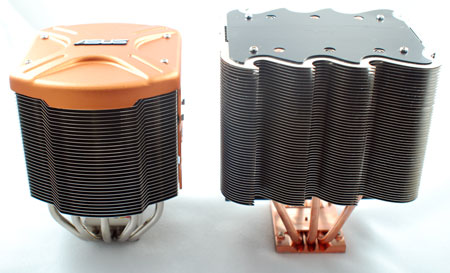
The ASUS Silent Square Pro is a very interesting design in the top-of-the-line Silent Square series. It resembles the Tuniq Tower 120 in concept, in that the cooling fan is embedded in the center of the cooler with cooling fin arrays on both sides. However, the Silent Square uses a smaller 90mm fan compared to the standard 120mm fan used in the Tuniq. As you can see from the comparison photo this makes for a much smaller cooler than the Tuniq. The Tuniq Tower 120 is one of the best performing coolers tested at AnandTech, so the same idea in the smaller ASUS Silent Square Pro definitely generated some interest in our labs.
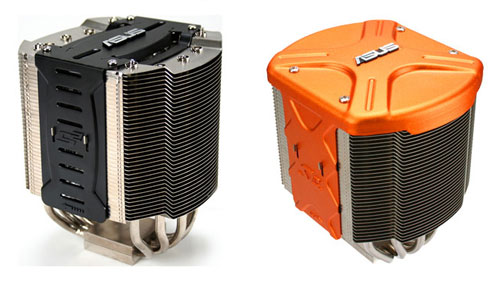
Silent Square is actually a series of two coolers at ASUS. The core of the Silent Square and the Silent Square Pro are basically the same. The Pro model adds a 2500 RPM fan instead of the 1800 RPM fan used in the Silent Square. Additionally, there is cladding that directs airflow and helps create a distinct appearance for the Pro version. The SS Pro also includes a fan controller that mounts in a 3.5" bay with a blue digital readout of the fan speed. It's a nice touch and a welcome way to vary fan speed.
S.Q.U.A.R.E.
Some readers are probably wondering why ASUS named this cooler the Silent Square since it is most certainly not square in shape. Square is actually an acronym and not a description in ASUS speak. The website defines the meaning and features of SQUARE:
Superior Performance for Overclockers
The Silent Square Pro incorporated a "wave-shaped" double side fin design on both sides of the cooler for larger heat exchange area.
Quick
Five copper heatpipes efficiently transfer heat to the fins, maintaining temperature for high-performance computing.
Universal Application
The Silent Square Pro supports the Intel Core 2 Extreme/Duo and other LGA775 CPUs as well as socket 478 processors; it also supports AMD socket 754/939/940/AM2 CPUs.
Aesthetics
Stylish wave-shaped fins for effective heat dissipation.
Reliable
The fan positioned inside the frame and VRM shield guide cool air to critical components around the CPU for stable operation.
Easy Installation
The patented retention module enables easy installation in three simple steps even without removing the motherboard from the system or memory modules from the board and regardless of the processor platform.
These features set a high bar for the ASUS Silent Square Pro. We have reviewed a number of air coolers that excel in performance for the overclocking enthusiast. Will the more compact ASUS Silent Square join the top ranks of Enthusiast coolers?
ASUS Silent Square Pro
Like most ASUS boards and components, the Silent Square Pro is a stand-out package. This package repeats the Silent Square Pro color scheme of orange spread across a black background.
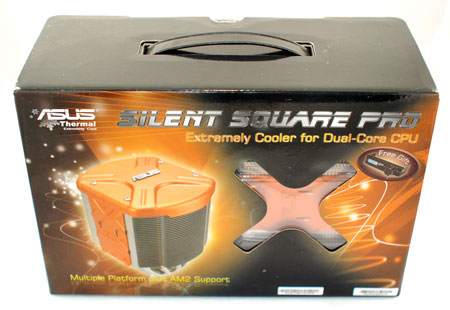
Unlike some competing products which try to tell you everything on the package, ASUS presents some nice photos of the product and the basic product specifications. The large Silent Square package contains the cooler protected by a rigid plastic clamshell and a smaller component box with adapters, instruction manual, and fan controller. As you would expect from ASUS the impression left by the packaging and attention to detail is one of quality.
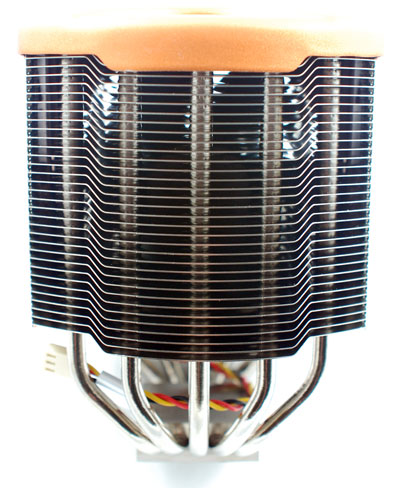
The Silent Square Pro and Silent Square use the same base heatsink, but different fans and cladding. Five U-shaped heatpipes support front and back cooling fin arrays with a 90mm fan sandwiched in the middle of the heatsink. This is the same idea used by the Tuniq Tower 120 on a smaller scale. Unlike the Tuniq, which uses a common and easily replaced 120mm fan, the Silent Square uses a very uncommon 90mm fan. This means you will likely be forced to run the Silent Square coolers with the stock fans.
The Pro mounts a 2500 RPM fan and the regular Silent Square mounts an 1800 RPM fan. Both coolers shroud the heatsink to direct airflow. The Pro goes even further with top and side covers with airflow arrows embossed on the orange covers.
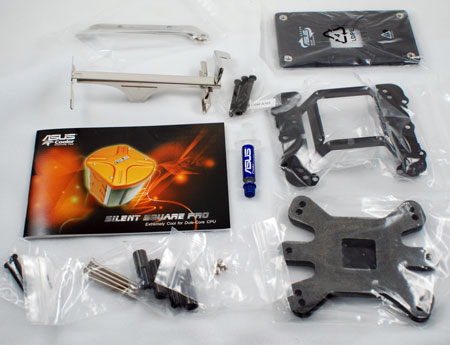
There are no mounts installed on the shipping ASUS Silent Square Pro, but the kit includes mount adapters for Intel 775 with two different backplates for different motherboard configurations. Mounts for AMD 754/939/940/AM2, and Intel 478 are also included. Since we have inadvertently killed a couple of motherboards with other "universal" back plates shorting rear solder points, it was good to see a second much improved plastic 775 back plate included. Also included is a small syringe of premium ASUS thermal paste and a clear set of color installation instructions.
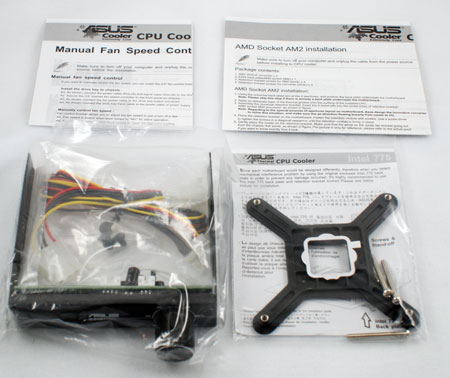
As mentioned, the ASUS Silent Square Pro includes a 3.5" bay fan controller with a blue led fan speed layout. This useful accessory makes it very easy to control fan speed and noise of the Silent Square Pro. Mounting in a 3.5" bay was easy and the connecting wires were long enough to reach from the bay to the cooler in most case designs.
You will need to remove the motherboard to install the ASUS Silent Square, but the mount installation is still simple on most motherboards. The holding clamp is a turn clip like you see on K8/AMD coolers. It installs quickly. Unfortunately, if your motherboard places the CPU socket near the top edge of the board, like the 680i does, you will have difficulty pushing the clip on a mounted board; there just isn't enough space between the socket and the power supply with the CPU near the edge. In that case you will need to unscrew the board just to push and lock the retention clip.
The Silent Square is still a big cooler, though it is a good deal smaller than a Tuniq Tower 120. It also weighs 745g (26.3 ounces), which is heavy for a cooler the size of the Silent Square. Fortunately the mounting method is very secure and it appears to distribute the weight evenly, which should provide some additional safety.
Since the motherboard must be removed for mounting the Silent Square, it is best to install the heatsink before remounting the board. We overlooked the clearance issue with the mounting clip and ended up having to remove the motherboard to push the clip and then remount the board. Installing the heatsink while the board is out of the case avoids additional difficulties.
The Silent Square is smaller than most other heatpipe towers and did not overhang the DIMM slots on any board we had in the lab. We also had no problem with clearance on any of the boards we had in the lab.
Specifications
The Silent Square will mount on all current CPU sockets. It also will mount on the older Intel socket 478.
| ASUS Silent Square Pro Specifications | |
| Heatsink | |
| Dimensions | 120(L) X 1105(W) X 158(H)mm (excluding fan) |
| Weight | 745g (including fan) |
| Material | Copper Base and Nickel-Aluminum Fins with Five Copper Heatpipes |
| Fan Configuration | Embedded 90mm |
| Included Fan | |
| Fan Size | 90mm x 90mm x 25mm |
| Bearing | Sleeve |
| Noise Level | Not specified |
| Speed | 2500 RPM (1020 to 2280 RPM) |
| Maximum Air Pressure | 3.3mm-H2O |
| Maximum Airflow | 49.4 CFM |
The fan included with the Silent Square Pro moves a lot of air for a 90mm fan, though the output would be considered moderate in a 120mm fan. The cooling fins are very closely spaced in the Silent Square design - closer than we have seen in other heatpipe towers. Fan noise level is not specified, but ASUS calls the cooler "silent". We will measure noise levels at low and high fan speeds in our testing.
CPU Cooling Test Configuration
The standard test bed for cooling tests uses an EVGA NVIDIA 680i SLI motherboard. This is primarily based on the consistent test results on this board and the excellent NVIDIA Monitor temperature measurement utility, which is part of the nTune program. The 680i chipset is also one of the better options for socket 775 CPU overclocking, and it provides great flexibility in our standard cooler tests which overclock to the failure limit with each cooler tested.
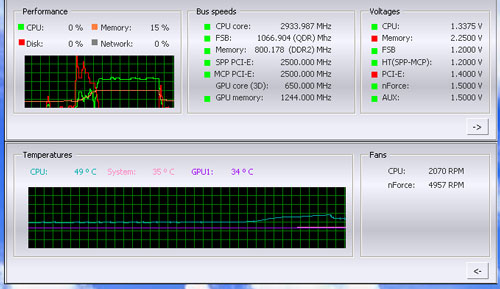
NVIDIA Monitor has a drop-down pane for temperature measurement which reports CPU, System, and GPU results. Reviews at this point will concentrate primarily on CPU temperature. In addition to the real-time temperature measurement, NVIDIA Monitor also has a logging feature which can record temperature to a file in standard increments (we selected every 4 seconds). This allows recording of temperatures during testing and play back, for example, of stress test results that can then be examined when the stress tests are completed. There is also the handy reference of speeds and voltages in the top pane to confirm the test setup.
NVIDIA Monitor was compared to test results from the Intel TAT (Thermal Analysis Tool). Intel TAT CPU portions do function properly on the EVGA 680i motherboard, but the chipset-specific features do not operate as they should. Idle temperatures in TAT were in line with measured Idle temps with NVIDIA Monitor. The CPU stress testing with TAT pushing both cores showed TAT stress temps at 80% CPU usage roughly corresponded to temps reported in our real-world gaming benchmark.
Other components in the cooling test bed are generally the same as those used in our motherboard and memory test bed:
| Cooling Performance Test Configuration | |
| Processor | Intel Core 2 Duo X6800 (x2, 2.93GHz, 4MB Unified Cache) |
| RAM | 2x1GB Corsair Dominator PC2-8888 (DDR2-1111) |
| Hard Drive(s) | Hitachi 250GB SATA2 enabled (16MB Buffer) |
| Video Card: | 1 x EVGA 7900GTX - All Standard Tests |
| Platform Drivers: | NVIDIA 9.53 |
| NVIDIA nTune: | 5.05.22.00 (1/16/2007) |
| Video Drivers: | NVIDIA 93.71 |
| CPU Cooling: | ASUS Silent Square Pro Scythe Ninja Plus Rev. B OCZ Vindicator Thermalright Ultra 120 Extreme Thermalright Ultra 120 Scythe Infinity Zalman CNS9700 Zalman CNS9500 Cooler Master Hyper 6+ Vigor Monsoon II Lite Thermalright MST-9775 Scythe Katana Tuniq Tower 120 Intel Stock HSF for X6800 |
| Power Supply: | OCZ PowerStream 520W |
| Motherboards: | EVGA nForce 680i SLI (NVIDIA 680i) |
| Operating System(s): | Windows XP Professional SP2 |
| BIOS | Award P24 (1/12/2007) |
All cooling tests are run with the components mounted in a standard mid-tower case. The idle and stress temperature tests are run with the case closed and standing as it would in most home setups. We do not use auxiliary fans in the test cooling case, except for the Northbridge fan attached to the 680i for overclocking.
Since ASUS provided a small syringe of a premium thermal compound, we tested with the ASUS thermal compound. In our experience the thermal compound used makes little to no difference in cooling test results. This is particularly true now that processors ship with a large manufacturer-installed heatspreader. Our only control on thermal compound is that we use the manufacturer-supplied product if they supply a premium product, or a standard high-quality thermal paste if a premium brand is not supplied.
We first tested the stock Intel cooler at standard X6800 speed, measuring the CPU temperature at idle and while the CPU was being stressed. We stressed the CPU by running continuous loops of the Far Cry River demo. The same tests were repeated at the highest stable overclock we could achieve with the stock cooler. Stable in this case meant the ability to handle our Far Cry looping for at least 30 minutes.
The same tests were then run on the cooler under test at stock, highest stock cooler OC speed (3.73GHz), and the highest OC that could be achieved in the same setup with the cooler being tested. This allows measurement of the cooling efficiency of the test unit compared to stock and the improvement in overclocking capabilities, if any, from using the test cooler.
Noise Levels
In addition to cooling efficiency and overclocking abilities, users shopping for CPU cooling solutions may also be interested in the noise levels of the cooling devices they are considering. Noise levels are measured with the case open on its side and are measured using a C.E.M. DT-8850 Sound Level meter. This meter allows accurate sound level measurements from 35b dB to 130 dB with a resolution of 0.1 dB and an accuracy of 1.5 dB. This is sufficient for our needs in these tests, as measurement starts at the level of a relatively quiet room. Our own test room, with all computers and fans turned off, has a room noise level of 36.4 dB.
Our procedures for measuring cooling system noise are described on the page reporting measured noise results comparing the stock Intel cooler and recently tested CPU coolers to the ASUS Silent Square Pro.
Cooling at Stock Speed
Some users will never overclock their CPU, but they still want to run the coolest CPU temperatures possible to enhance stability and extend CPU life. The ASUS Silent Square Pro kit includes a moderate output low noise 90mm fan. This is an unusual fan size which makes it difficult to find a fan to replace the stock fan.
Initial test with the Silent Square showed extremely poor results at idle at 3.73GHz. We have seen several Silent Square reviews that reported poorer performance with socket 775 than with socket AM2. This led us to suspect that the mounting plate was not flat or the mounting method did not provide enough CPU contact for effective cooling. The cooler was removed and thermal paste was spread evenly on both mounting surfaces indicating good contact. However the thickness of the paste indicated more pressure was needed on the cooler mount. After experimenting we found that adding two thicknesses of plastic credit card under the clip that holds the cooler against the CPU was most effective in cooling the CPU. Temperatures dropped from 55C idle with a stock install to a more reasonable 42C at idle with the credit card shims.
These findings may explain the poorer performance on socket 775 processors reported elsewhere. It appears the mounting clip needs a tighter coupling to the processor for better cooling on LGA775. This can be accomplished by shortening the stand-offs a small amount on the universal retention mount or by using shims under the mounting clip. Both methods worked fine in benchmark testing. Out of the box, it appears the socket 775 attachment is flawed in the ASUS Silent Square.
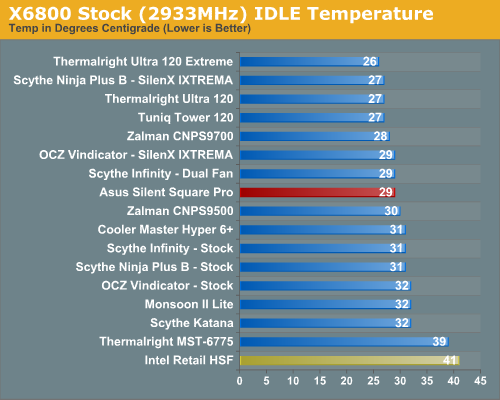
With the stock fan at stock speeds with the modified install of the Silent Square Pro, temperatures were an impressive 29C compared to the 40C with the unmodified 775 install. These results compare favorably to stock idle results with the better coolers tested at AnandTech.
It is more difficult to effectively simulate a computer being stressed by all of the conditions it might be exposed to in different operating environments. For most home users CPU power is most taxed with contemporary gaming. Therefore our stress test simulates running a demanding contemporary game. Results are comparable to running the Intel TAT stress test at 80% CPU usage.
The Far Cry River demo is looped for 30 minutes and the CPU temperature is captured at 4 second intervals with the NVIDIA monitor "logging" option. The highest temperature during the stress test is then reported. Momentary spikes are ignored, as we report a sustained high-level temp that you would expect to find in this recording configuration.
Cooling efficiency of the ASUS Silent Square Pro was tested under load conditions with the stock fan at stock speed. Results are compared to the Intel retail HSF and other recently tested CPU coolers.
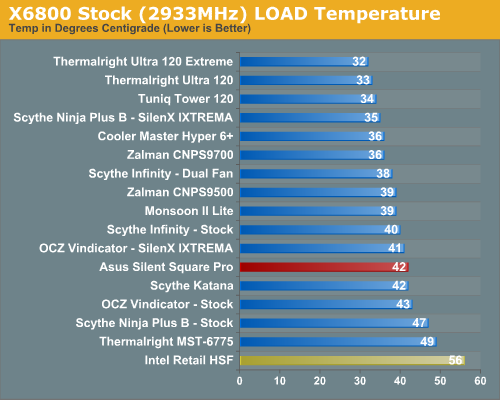
The Silent Square Pro under load at stock speeds reached a maximum temperature of 42C. This result was not nearly as impressive as performance at stock idle. However, keep in perspective that the Intel retail fan under load at stock speeds reached 56C, so the ASUS Silent Square Pro is a significant improvement of 14C in cooling performance compared to the Intel retail HSF. Top coolers in our test like the Thermalright Ultra 120/Ultra 120 Extreme and Tuniq Tower 120 reached low to mid 30's Centigrade under these same test conditions.
The ASUS Silent Square Pro is a decent cooler at stock speeds and a big improvement over the Intel retail cooler. At idle its performance is among the best we have tested, while under load it falls in the middle of the pack for performance of the coolers we have tested. ASUS advertises the Silent Square Pro as ideal for overclocking the Core 2 Duo, however. They also classify the cooler as developed for the gamer. To test those claims we took a closer look at cooler performance scaling.
Scaling of Cooling Performance
The Thermalright Ultra 120 Extreme has been the top performer so far in CPU cooling at stock speeds. As overclocks are raised, the Ultra 120 with the Scythe SFLEX fan maintains its cooling advantage. The ASUS Silent Square Pro is below average in cooling efficiency as CPU speeds are increased - even with the modified installation to improve socket 775 cooling performance.
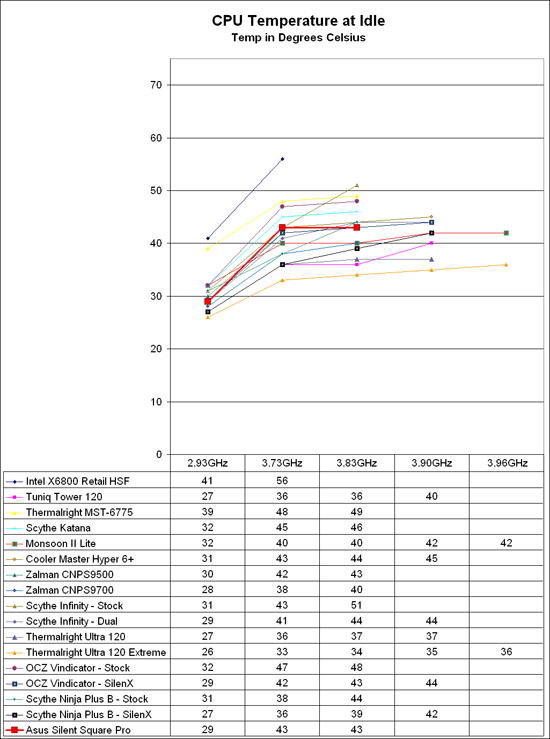 |
| Click to enlarge |
At 2.93GHz the retail HSF is running at 41C, compared to 29C with the Silent Square Pro. This is a delta of 12C and an excellent performance. The delta with the stock fan to Intel retail remains similar at idle as the CPU speed is increased. By 3.73GHz the idle with the retail fan is 56C compared to the Silent Square stock at 43C - a delta of 13C
Cooling efficiency of the ASUS Silent Square Pro was then tested under load conditions, where much poorer cooling performance was observed. Results are compared to the retail HSF and other recently tested CPU coolers. The Silent Square Pro generated results very comparable to the Zalman 9500. The 9500 is a cooler which excels in cooling at stock speeds, but which is not nearly as efficient once the CPU is overclocked to higher frequencies - at least when compared to the best coolers tested at AnandTech.
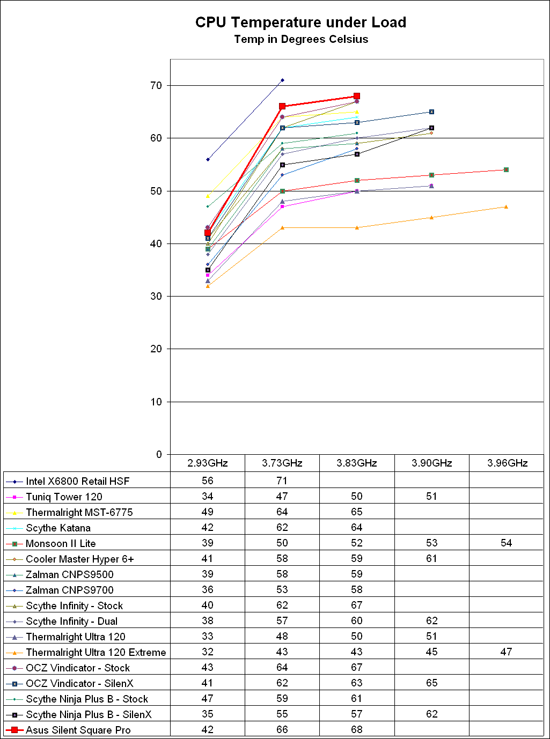 |
| Click to enlarge |
The ASUS Silent Square topped out a stable clock speed of 3.81 GHz - only a little better than the Intel Retail cooler at 3.73GHz and poorer than the 3.90GHz reached with stability with the better heatpipe towers in our cooling performance tests. 3.90 GHz is the highest overclock the Tuniq, Thermalright Ultra 120, OCZ Vindicator, and push-pull Scythe Infinity could reach with stability. At 3.81GHz under load the Silent Square was at 68C compared to the Tuniq Tower 120 at a similar speed at 50C, and the top Thermalright Ultra 120 Extreme/Scythe SFLEX at 43C.
Our test methodology uses real gaming at overclocked speeds to test the cooling efficiency of the unit under test. From this perspective the performance of ASUS Silent Square Pro is a disappointment. Even with the modified mount to improve cooling, the overclocked gaming cooling is below average among top heatpipe towers tested at AnandTech.
As stated many times, the overclocking abilities of the CPU will vary at the top, depending on the CPU. This particular CPU does higher FSB speeds than any X6800 we have tested, but the 3.9GHz top speed with the top tier heatpipe towers is pretty average among the X6800 processors we have tested with Tuniq cooling. A few of the other processors tested with the best air coolers reach just over 4 GHz, but the range has been 3.8 to 4.0GHz. Stock cooling generally tops out 200 to 400 MHz lower, depending on the CPU, on the processors tested in our lab.
Overclocking
As cooling solutions do a better job of keeping the CPU at a lower temperature, it is reasonable to expect the overclocking capabilities of the CPU will increase. In each test of a cooler we measure the highest stable overclock of a standard X6800 processor under the following conditions:
CPU Multiplier: 14x (Stock 11x)
CPU voltage: 1.5875V
FSB Voltage: 1.30V
Memory Voltage: 1.90V
nForce SPP Voltage: 1.35V
nForce MCP Voltage: 1.7V
HT nForce SPP <-> MCP: Auto
Memory is set to Auto timings on the 680i and memory speed is linked to the FSB for the overclocking tests. This removes memory as any kind of impediment to the maximum stable overclock. Linked settings on the 680i are a 1066FSB to a memory speed of DDR2-800. As FSB is raised the linked memory speed increases in proportion. The same processor is used in all cooling tests to ensure comparable results.
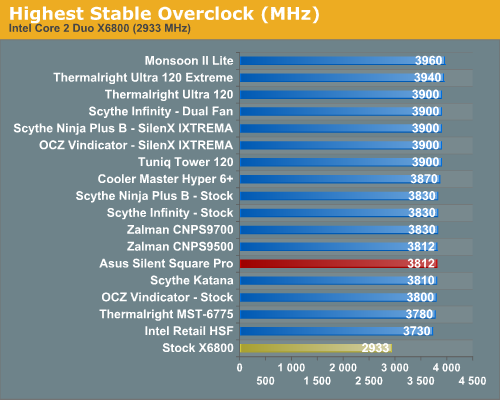
The ASUS Silent Square Pro could only reach 3.81 GHz overclock with stability. This is a poor performance for a cooler targeted at the gaming market. These results are not comparable to the top tier of the heatpipe towers tested, where most top heatpipe towers reach 3.90 GHz with the same CPU and 3.94 GHz for the top performing cooler.
The design of the cooler is very similar to the Tuniq Tower 120, which suggests the ASUS Silent Square Pro should be an effective design. These results were with our modified installation that lowered temperatures, so the comparatively poor results cannot be blamed on a poor mount. We suspect that the performance is hampered by the smaller 90mm fan, which has to work harder to move air due to the smaller size. The odd 90mm fan size also makes replacing the 49.6 CFM fan with something better an unlikely event. It will be difficult to find any fans that will fit the Silent Square Pro. The smaller heatsink size is also a possibly factor in the lower cooling performance.
Noise
For many enthusiasts upgrading cooling the goal is maximum stable overclock, and they will live with the inconvenience of a louder system. For other users silence is the most important factor, and these users will forgo maximum overclocking if that increases system noise levels.
There are virtually no power supplies that do not include a fan. While Zalman and a few others do make an expensive fanless power supplies, we have not seen a fanless unit larger than 500W, or one that would be used for seriously overclocking a system. With that in mind the noise level of the system with all fans turned off except the power supply was measured. The power supply used for the cooling test bed was the OCZ PowerStream 520, which is one of the quieter of the high performance power supplies.
We have also measured the Corsair 620-watt and Mushkin 650-watt power supplies which are reported to be quieter than the OCZ. Both the Corsair and Mushkin are indeed quieter at idle or start up speed. However, as soon as load testing begins and the PSU fan speed kicks up the measured noise level is almost exactly the same as the OCZ PowerStream 520 watt power supply.
We are currently in the process of evaluating "quieter" power supplies for an update to our cooler test bed. We will make changes to that test bed as soon as we are confident in the noise measurements and test procedures with a variable speed quiet PSU. We plan to evaluate additional power supplies and configurations in our upcoming 120mm fan roundup, at which point we will complete the transition to a revised and lower noise cooler test bed.
The noise level of the power supply was 38.3 dB from 24" (61cm) and 47 dB from 6" (152mm). The measured noise level of the test room is 36.4 dB, which would be considered a relatively quiet room with a noise floor slightly below the OCZ PowerStream 520 PSU.
We measured noise levels with the ASUS Silent Square Pro under both load and idle conditions. Results were then compared to the system noise floor. The fan did not have a specified noise rating, but we suspected higher noise levels than we typically find with the better 120mm fans. The smaller 90mm fan in the Silent Square Pro turns at 1020 RPM on lowest speed and it turns at a much faster 2500 RPM at full speed. These are much higher fan speeds than we typically see in 120mm fans and a sleeve bearing fan is not likely to hold down the noise from the increased fan speeds.
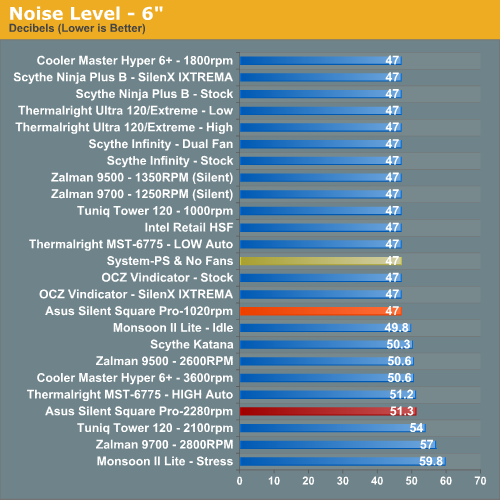
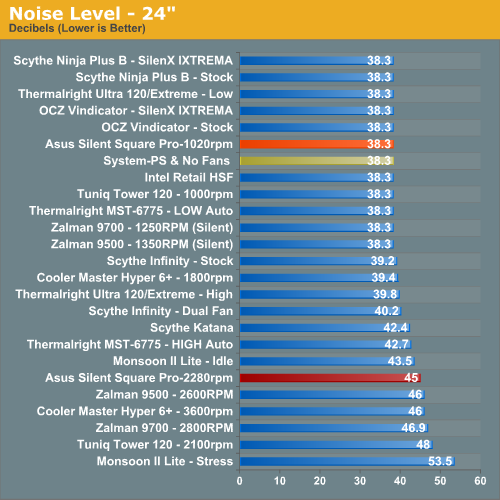
Measured noise levels in this chart should be considered worst case. Measurements were taken with an open side of a mid tower case 6" and 24" from the HSF. Real world would be a completely closed case resulting in a further reduction in noise.
At the minimum speed of 1020 RPM the measured noise at 6" and 24" is below the system noise floor. However, minimum speed does reduce cooling efficiency with idle cooling increasing from 30C to 33C and load cooling increasing to 48C from the max speed 42C. Cooling at lower speeds is not as good, but the system still will run fine all day long at stock speeds with the low-speed fan. Don't, however, expect to overclock much with the fan on minimum.
At the maximum rated speed of 2500 RPM (measured 2280 RPM) noise is above the system floor. Even at idle the 44.6 dB-A noise from the fan will be heard. It is even more pronounced under load at full fan speed with a 51.3 dB-A rating. ASUS calls this cooler the Silent Square Pro, but it is reasonably silent only with the fan speed and cooling efficiency turned way down. At rated fan speed the ASUS Silent Square Pro can definitely be heard in your system.
The odd 90mm fan size makes finding a fan to improve noise performance unlikely. The fan is a standard 25mm thick so it may be possible to replace the fan with a better one if you can find a better 90mm fan. The fan mounts in the center of the cooler.
Final Words
The Silent Square Pro is the top cooler in ASUS' Silent Square "Gamer" series, which is the top cooler line produced by the Thermal Solutions group at ASUS. This is the same ASUS that is well known to any computer enthusiast as one of the largest and most prolific manufacturers of quality motherboards. ASUS is a tier-1 manufacturer who is often first to market with new chipsets and technology.
The Silent Square Pro is beautifully packaged and exquisitely finished. It is almost like an orange gem with a clear heritage of breeding and attention to detail. If looks alone were all that mattered then the Silent Square Pro would be the Miss Universe of the computer cooler set. However, my mother and yours probably warned you that "beauty is as beauty does". By that yardstick the Silent Square Pro is the ugly stepsister since it really "does" very little compared to other top heatpipe coolers.
This starts with the socket 775 mount on the Silent Square Pro. Either we had a bad sample or the design doesn't apply enough pressure to the socket 775 CPU for a good fit and proper cooling. By shimming the attachment clip we were able to reduce the idle temperature at a 3.73 GHz overclock from 55C to a more rational 42C. That, however, did not improve cooling performance in overclocking enough for the Silent Square Pro to be competitive with comparably priced heatpipe towers we have tested.
At stock speed the ASUS Silent Square Pro is a good performer, maintaining the CPU temp at 29C idle and 42C under load. This compares favorably with coolers targeted at silence like the Zalman 9500 and 9700. Despite the name, at full speed the fan is not silent, with idle and load noise clearly louder than the system noise floor. However, a slight reduction in speed moves noise below the system floor. Running "silent" at minimum speed the cooling is 33C idle and 48C load, which is still okay cooling in this worst case scenario. It is easy to find a happy and reasonably silent fan speed in the middle with the included digital readout fan controller. As a quiet cooler at stock speeds the ASUS Silent Square Pro is a big improvement over the stock Intel cooler. It cools better and it is certainly a lot prettier in your case than the Intel Retail HSF.
But ASUS advertises the Silent Square Pro as the ideal cooler for Core 2 Duo overclocking and gaming. Compared to other top coolers the Silent Square Pro is not a particularly good cooler for C2D overclocking. OC tops out at 3.81 GHz, where the Tuniq Tower 120, Scythe Infinity push-pull, OCZ Vindicator/SilenX, Scythe Ninja Plus B/SilenX, and Thermalright Ultra 120 all overclock to a stable 3.90GHz. The Thermalright Ultra 120 Extreme, our top air cooler so far, goes even further to 3.94 GHz. The less-than-top overclocking of the Silent Square Pro is compounded by the smaller and non-standard 90mm embedded fan. If a better replacement could be found the Silent Square Pro might be a better overclocker.
For gaming, we are talking about conditions similar to 80% CPU load, and the Silent Square Pro is not the best performer under load conditions either. Temperatures under load are not really competitive with the best coolers we have tested. Again the small fan with lower output is likely the issue. A higher output fan - if one were available - would likely solve much of this issue as well.
The ASUS Silent Square Pro is a beautiful and well-made compact heatpipe tower. However at a price from $41 for the lower-priced Silent Square online to as much as $70 for the Silent Square Pro, we do not find the cooler to be a very good value. Almost all of the top air coolers we have tested fall in this same price range, but most of them outperform and out-silence the Silent Square Pro. The Silent Square Pro competes better against mid-priced coolers in the $25 to $30 price range. None of these mid-range coolers look as fantastic as the ASUS Silent Square Pro, but if you are looking for performance the $25 to $30 coolers perform at about the same level as the more expensive Silent Square Pro.
As a quiet and effective stock-speed cooler the ASUS will please you. With a reworked socket 775 mount and a higher output fan the Silent Square Pro might even compete with the best. However, as it is now configured the Silent Square Pro is a beautiful diva who promises you everything, but then leaves you stranded all alone with nothing but the check from an expensive dinner.







